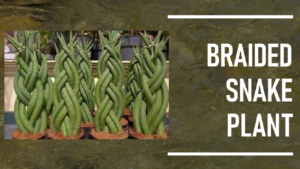Do you know indoor plants need a lot of pruning for many reasons?
Pruning indoor plants not only makes the plant healthy but also makes them look better. Pruning your indoor plants regularly to maintain them healthy and to stimulate a balanced growth pattern.
Pruning is like a haircut given to a plant that can give an intimidating appearance and can make your home or garden look beautiful. But pruning the indoor plants can be scary if you are a beginner like me. I personally found pruning to be very difficult as there are different ways of pruning different plants in different seasons.
So, what is the right way to prune an indoor plant? Before I explain to you how to prune, let’s find out when and why you should prune indoor plants!
WHEN SHOULD YOU PRUNE INDOOR PLANTS?
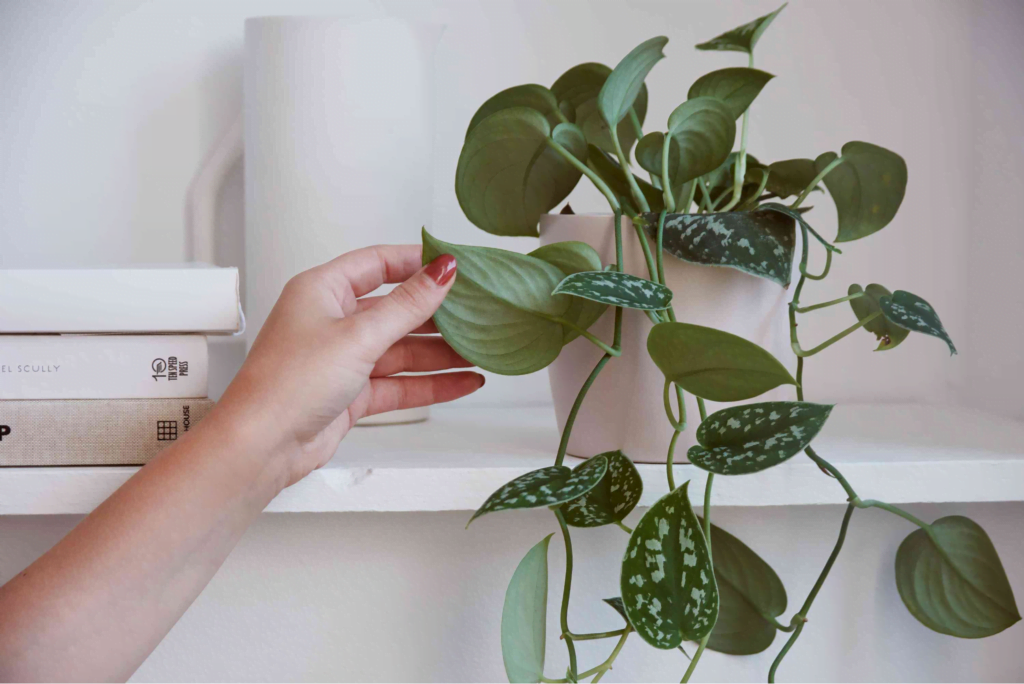
The best time to prune an indoor plant is always before its growing season. Usually, the growing season of indoor plants is in spring. So, if you are planning to prune, try to plan before spring, that is winter or early spring. But, if you have woody indoor plants in your home, then prune those plants regularly, because they produce more dead leaves and stems throughout the year. However, you should remove dried leaves and flowers regularly for any plant.
In spring, there is enough sunlight to enhance the new growth of any plant. For flowering species, pruning should be done only after they stop flowering. Otherwise, be careful because you might be trimming the unopened buds.
WHY SHOULD YOU PRUNE INDOOR PLANTS?

Being plant lovers, many of us grow plants whether indoor or outdoor. In this urban life that we are living now, some of us cannot maintain a big garden outside the house. Not many of us have big spaces to have a garden outside; but, somehow we manage to grow some indoor plants in our home, inside our little spaces that we live in and so, we love to have them.
Now, after consulting with my friends, neighbors, and some of my personal experience as a home gardener, I realized that our lovely indoor plants are growing big and we may not have enough space to let them grow and we cannot throw them out too.
And therefore, I found a solution to this problem that is called “PRUNING”. I don’t know about you but before I often prune my plants
by plucking old and discolored flowers or leaves. But, in this article, I will guide you in detail to learn about how to prune indoor plants. Before I teach you how to prune, let’s find out how pruning can benefit your indoor plants.
Pruning is not only to clear some spaces in the house, but it also helps the plant to overcome a lot of things such as:
1. Decreases the Growth of Fungus
Pruning helps in decreasing the growth of fungus. If a part of your indoor plant is infected, due to overwatering, lack of airflow, or may be due to some pests. They may start growing on the infected part and spread throughout the plant.
Thus, it may finally become the cause of the plant’s death. So, it is very important to prune the infected part, stop the fungus growth and make your plant healthy and strong.
2. Improves the Airflow
Pruning improves the airflow to all the parts of your indoor plants. Like humans, plants need air to survive too. Sometimes, some leaves overgrow in the plant covering the other leaves of the plant.
So, in this case, the leaves that are hidden by other leaves or stems may become mushy and get infected due to lack of airflow. You may miss to notice them and the fungus can spread throughout the plant. That is why, pruning the overgrown stems will increase the airflow to all the parts of the plant.
3. Allows the other Parts of the Plants to Grow
Pruning the overgrown stems or branches of the plant, allows the plant to grow slowly. The energy consumed by the overgrown stem is distributed among the other stems of the plant, after pruning it. Even dead leaves and dried flowers consume some energy. So, pruning helps the plant to get more growth to all the parts equally.
4. Makes your Plant Look Nicer
Finally, pruning makes your plant look nice and beautiful. Trimming all the dead, discolored leaves and dried flowers, gives your plant a good new look like a new haircut. Remember, you should not over-prune and always plan your cuts before to give your plant a good shape.
So, now you know when and why you need to prune your indoor plants; next you must know what steps you need to take before you start to prune and how you should plan to prune!
BEFORE PRUNING YOUR INDOOR PLANT

Before you start pruning, there are some steps you should follow to avoid infection in the plants and to your hands. Let’s check out these steps below:
- Before pruning your indoor plant, always decide the best time to prune, then take out the tools required to prune.
- Sanitize the tools before pruning, because if the tools are dirty, these can cause some infection to the plant.
- Also, select the tools which are sharp and ready to use.
- Make sure to have your gloves so that your hands will not become dirty.
- Put a piece of cloth or paper on the surface before you start pruning, because some plants may expel sticky sap that may be allergic to your skin and stick to the floor.
HOW TO PLAN YOUR CUTS?
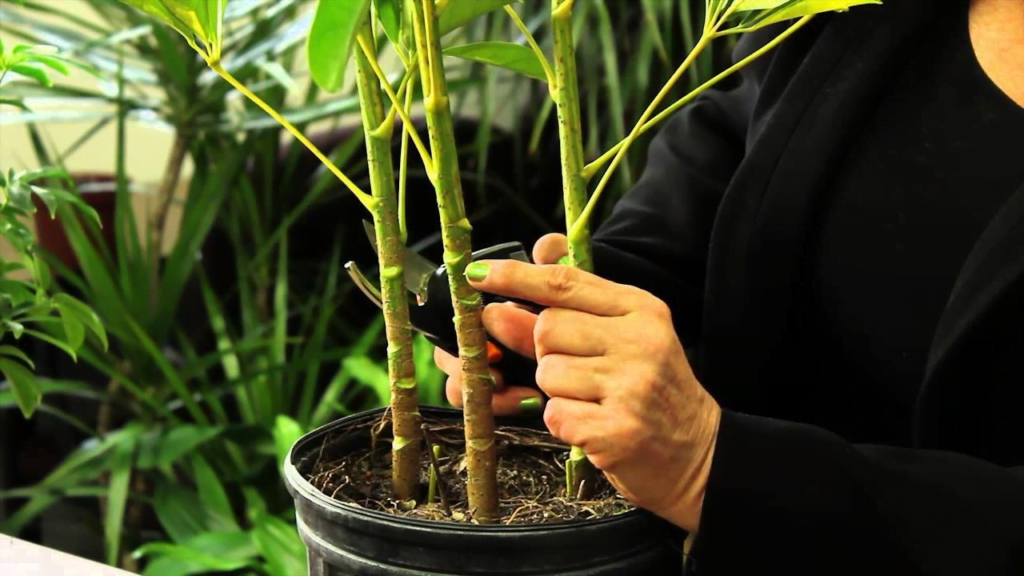
I know you might be having some questions in your mind like how should I plan my cuts?, what happens if I suddenly overcut my plants, and many more.
Worry not, my fellow plant companions, as I have included some steps for you to follow while you are planning to cut or trim your dear plants:
- Plan your cuts before to make your plant look better. Imagine how you want to see it and decide where to cut it to make it beautiful. Once you cut a stem of the plant, you cannot get it back. So, turn the vase around and plan your cuts.
- Remember that, you should first trim all the discolored, spotted, dried leaves, flowers, stems and branches to make your plant look beautiful and managed.
- Always, keep in mind that some plants are sensitive and you cannot cut them more than 10% of their leaves while pruning. However, some plants allow you to trim them up to 25%. But, cutting more than 25% of any plant is not recommended.
- Prune your indoor plants in their crowded areas. If you think that any large stem is disturbing the plant’s growth, then get rid of that stem.
EQUIPMENTS YOU NEED BEFORE PRUNING
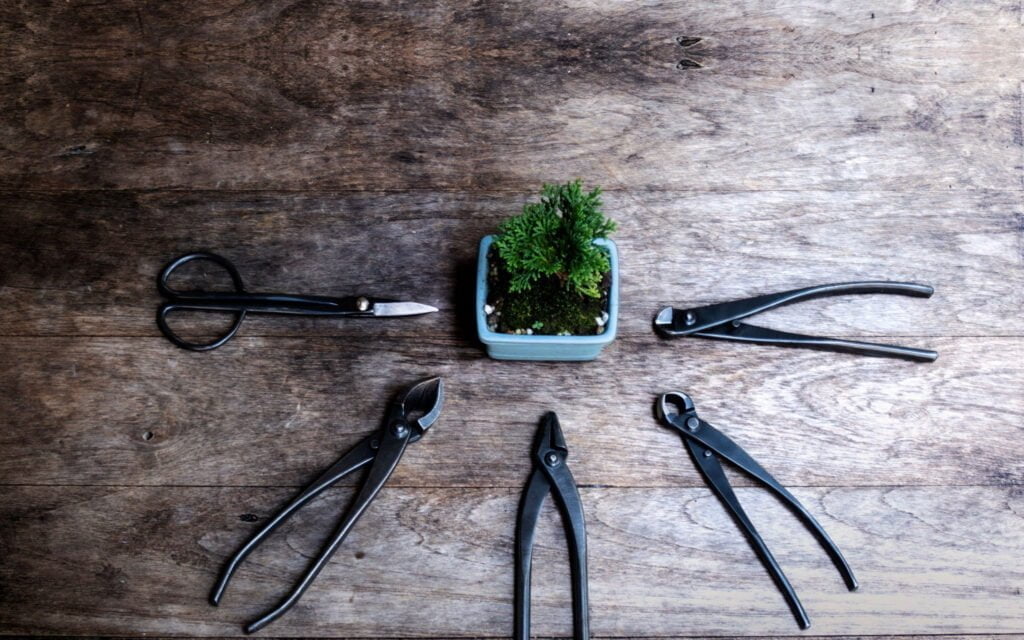
Do you know what type of tools you need for pruning?
Sharp scissors, garden shears, and gardening gloves are the tools you need during pruning. It is better to use paper, a piece of cloth, or a mat, to place the plant that you are about to prune.
Now you know everything about when, why and how to plan your pruning, let us discuss the processes that you need to know while pruning your plants!
PROCESS OF PRUNING

Check out the following processes that you need to keep in mind while pruning your dear plants:
1. Identification of areas to be pruned
As, we have discussed how you should plan the cuts before trimming and then start the pruning process by following the steps given below:
- The infected areas or dead parts
Infected areas like soft, mushy leaves or stems are formed due to root rot or some other disease and so, these leaves or stems should be pruned.
- Cut the overgrown branches or stems
Overgrown stems that consume much space in your house should be trimmed off. Remember, only half of the overgrown stem or branch should be pruned. This helps the tall plant grow bushy, and the bushy plant to grow tall.
- Cut the leggy stems
Leggy stems that cover the whole pot should be trimmed off. These stems may not overgrow but they can grow in a wonky direction that may not look good.
2. Using the correct tools
You should know which tool is required to prune your indoor plant. If your plant is thick, or if you are going to prune an indoor tree, then use gardening shears.
Also, use normal kitchen scissors if needed or if the plant is slender and thicker, then use gardening shears.
3. Separate the infected parts
First of all, sanitize your scissors and then gently cut the areas you want to cut off. And then, cut the selected area at an angle of 45 degrees with the main stem.
If a stem is infected at the root, then pull out the stem from the soil and cut the rotten part.
4. Best ways to prune
Always use clean and sharp scissors to prune. Do not pluck the leaves or stem with your hand even if the stems are strong. Do not crush the stems.
Prune the selected stem at a 45-degree angle instead of cutting it horizontally and also to avoid crushing the stem. Using scissors or shears makes your pruning easy and perfect.
5. Preparing the pruned parts for potting
First of all, prune all the dead, bushy or dried leaves and small stems of the main stem or the vine of your plant. Make it a deadhead, with the scissors.
And then, make enough cuts for the stem or vine to pot. Now, decide how many cuts you will be making to the deadhead stem. After that, make your cuts according to the size of the stem.
TIPS FOR PRUNING INDOOR PLANTS
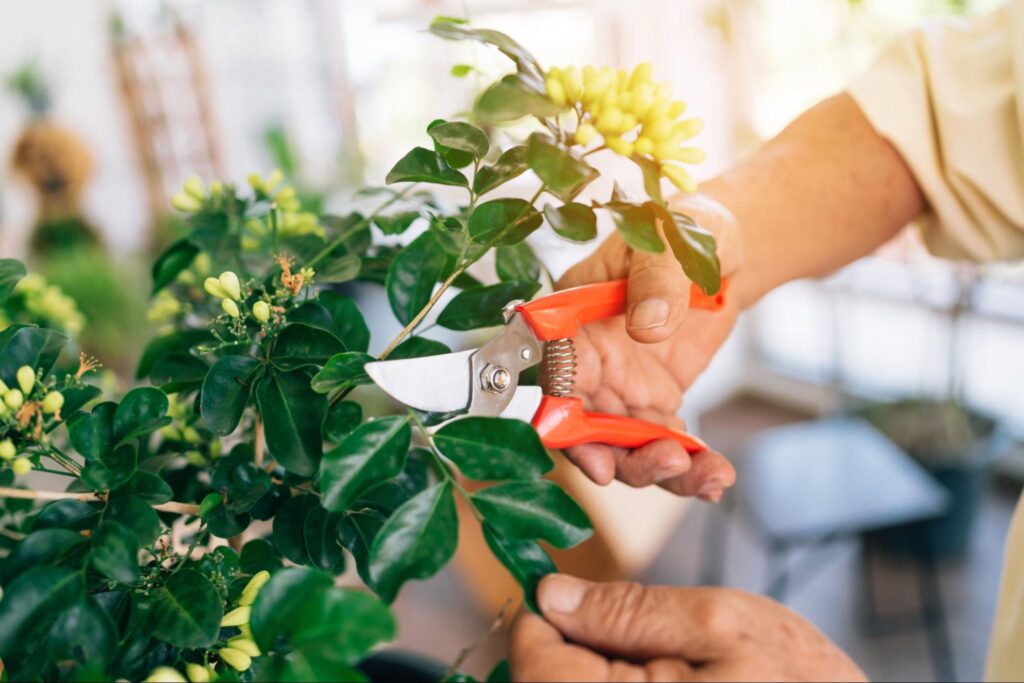
I have mentioned some important tips for you to follow that will help you to prune easily and quickly without hurting your dear plants. Let’s check them out below:
- Firstly, understand your plant’s growth pattern. New growth of your plant can be started at the tip of the plant and at the bottom of the plant. It means growth is manifested in the dominant bud. Also, trimming the tips of the stems just before the blooming season, can make your plant produce more flowers.
- Deadheading prolongs blooming and also makes the plant stronger. Cutting off the flowers, leaves, and small stems encourages new growth in the plant. Also, remember that, it should be done only if you are repotting the plant or you are propagating the stem.
- Make sure that your pruning equipment is sharp enough to cut the stems of your plant. Otherwise, it may damage the plant, by crushing it, or the plant might get infected by using blunt equipment. And so, it is better to prune your plant little by little and often.
- Pruning stems: You might find pruning stems or branches very easy if you follow the tips I have given below:
- First of all, be attentive while pruning the plant, because a second of neglect may cause damage to you and your plant.
- Take some time and prune slowly. If you don’t have time, then postpone your pruning process. But, do not spoil the look of your plant because once you cut the stem, you cannot undo it.
- If you want to cut a stem of your plant, then make sure you cut it at the joint of the main stem.
- If you want to cut a part of an over-long stem, then you have to cut above the leaf node.
- Pruning vines: Pruning vines is similar to pruning stems, but it involves some more detailed work. Generally, vines are encouraged to grow along with the given support. But if there is any stem that is growing sideways, then it can be pruned off. Also, make sure that you cut it with care and without disturbing the whole plant. The growth of the side stem may continue but you must have some patience to cut it more than 2-3 times or sometimes more than 3 times. Even vines should be pruned just above the leaf node to encourage new growth.
- Exclude only 20-25% of the plant: Pruning may be a way of caring for your plant, but some limits should not be crossed while pruning. A good rule of thumb says that any plant should not be pruned more than 25%. It is better if you leave with a radical shape. But, do not trim it by more than 20-25%. Every plant gets shocked by the removal of its parts and that may lead to a drop in its growth. However you can help it grow by fertilizing it, but you can do nothing if the plant gets pruned more than 25%. It will be a difficult task to compensate for the loss.
- Plants that should not be pruned: Some plants require very less pruning and some plants should not be pruned at all. For example, in the case of some species of Orchids, we cannot prune them except by removing the dead leaves. Also, all the pams and Norfolk Island pines have only terminal buds but they don’t produce latent buds. So, if you remove the terminal bud of such plants, it can lead to the plant’s death. That is why, try to avoid pruning the plants that should not be pruned. However, you can pluck off the dead leaves of these types of plants, but make sure you do not cut the growing part of the plant.
THINGS TO DO AFTER PRUNING
There are some steps you should follow after pruning of your plants:
1. Remove dust from the leaves
After you complete pruning your plant, some dust or dirt that may have evolved during the pruning process will remain on the leaves of the plant. It happens mostly because of pruning the roots or repotting the plant. Furthermore, your plant may have some dust on the leaves as they are left untouched for some days.
So, if you find dust on the leaves, it is time to remove the dust using a cotton cloth or sponge. Always keep in mind that the rag you are using to wipe a plant should not be used to clean another plant to avoid the transfer of pests from one plant to another.
Therefore, you should always continue this process and check your plant regularly to keep the plant tidy.
2. Water if it needs
As you must know your plant needings, water the pruned plant if it needs more. If you are a beginner and do not know whether it should be watered or not, then just do a little research on your plant and follow the suggestions that I have given below:
Do not overwater the plant. Check the soil, if it is dry then water it, normally. If it is damp and moist, then it is better to water it later.
3. Observe the plant after pruning
If the plant you have pruned is healthy, then it will recover from the loss in just a few weeks and start its new growth very soon. Recovery from pruning may vary from plant to plant and some plants may take a month to recover.
If the plant you pruned is not so healthy and drops its growth after pruning, and you have not over-pruned it, then it will bounce back if you fertilize your plant in the right way.
4. Fertilization
If you feel that the pruned plant got shocked by pruning and it is not growing even after a month, then it is time for fertilization to encourage growth.
Fertilize your plant with a soluble, all-purpose fertilizer. Read the directions to use before fertilizing it. It is better to dilute the fertilizer with water to avoid its harshness.
FAQs
Q1. How to cut a tall plant and make it bushy?
Answer: If it is a flowering plant, wait until it stops flowering. And then cut a part of the stem(which is 25%of the plant’s height) from the above. Continue the process at regular intervals. It will encourage the growth of side stems. Thus, it becomes bushy.
Q2. Shall I trim the roots that stick out of the soil?
Answer: No, do not cut those roots. As the roots are the delicate parts of the plant, cutting them will only kill your plant, if you do it in the wrong way. If the roots are sticking out of the soil, the plant is telling you that its container is too small for it. Repot the plant instead of cutting its roots.
Q3. What is the best time to prune indoor flowering plants?
Answer: The best time to prune indoor flowering plants is, soon after it stops flowering. If it blooms in every season, then prune the above stem and try to propagate it.
CONCLUSION
Pruning can be done for various reasons, but the main reason behind pruning is to save your plant. It may not be a bad thing if your plant overgrows indoors and you might have enough space to let them grow, but still pruning is a way of caring for your plant.
Pruning may be a difficult task, in the beginning. You might get worried about the cleaning process but after completion of pruning, it is quite easy if you follow the above given tips. The growth of the plant after pruning may also bother you. But, remember it is just like trimming the hair or cutting a nail of your plant (only, if you have not over-pruned it).
Also, it needs some time to recover from the loss. After all, pruning is not only a way of caring for your plant but also showing your love for the plant. Be attentive, do not be lazy to prune your plant. Prune it whenever it needs pruning.
I hope you like this article and if I have forgotten any step to mention above, please feel free to comment down in the comment section below! Also, don’t forget to follow us on social media!
Related Articles
- 15 Best Plants for Front Door Entrance India | Auspicious plants for front door
- 10+ Money plant Benefits That Will Make you Keep It In Your House
- Are Spider Plants Toxic to Cats?- 4 Ways To Prevent Your Cats From Eating Spider Plants.
- Best Plants for the House – 8 Top Apartment Plants That You Can’t Miss
- How to Braid Your Snake Plant: Tips and Care Guide
- 20+ Rare and Unusual Peace Lily Varieties You’ll Love




